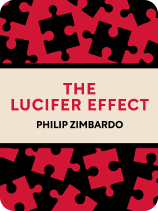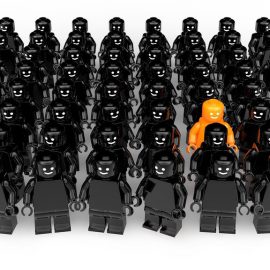

This article is an excerpt from the Shortform book guide to "The Lucifer Effect" by Philip Zimbardo. Shortform has the world's best summaries and analyses of books you should be reading.
Like this article? Sign up for a free trial here .
What is social pressure? What are the two types of social pressure?
Social pressure is the influence exerted on an individual or group by another individual or group. In The Lucifer Effect, psychologist Philip Zimbardo defines the two types of social pressure that influence someone to be evil: group pressure and authoritative pressure.
Keep reading to learn about the two types of social pressures.
Types of Social Pressures
So, what is social pressure? Zimbardo explains that social pressures are another major circumstantial variable with the power to influence us to act immorally. When the people around us want us to do something evil, it becomes significantly more difficult for us to resist. These social pressures come in two main forms that often overlap: group pressure and authoritative pressure.
Group Pressure
The first type of social pressure is group pressure. Zimbardo asserts that we all have a basic need to feel accepted by those around us. For this reason, when we find ourselves in new situations, we observe those around us to determine what behavior is appropriate. In this way, our morals often shift to match those of the people around us.
Zimbardo notes that if we perceive a group to be prestigious and exclusive, the pressure it exerts on us is even more powerful. Our human need to belong becomes stronger when combined with our desire for status. For example, a child who wants to be accepted by the “cool kids” may make fun of kids they would normally be friends with.
The Rationale Behind Group Pressure
In Influence, Robert Cialdini points out that we allow group pressure to shape our behavior for a good reason: Most of the time, when the majority of a group is doing something, it is the right thing to do. For example, say you’re walking down the sidewalk and see several people running panicked in the same direction. It would be reasonable to follow suit since they probably have a good reason to run.
Since this instinct to imitate those around us is hardwired in the human brain (as Zimbardo points out), we can assume that it has helped us survive since the early days of humanity. Our tendency to imitate those in prestigious groups makes sense through this lens, too—emulating those at the top of the dominance hierarchy would presumably increase our chances of becoming high-status ourselves.
Authoritative Pressure
The second type of social pressure is authoritative pressure. It’s when an individual or group in power bids you to do something. Zimbardo asserts that it’s far more likely that we will commit evil if we’re “just following orders.” While group pressure is indirect and sometimes accidental, authoritative pressure is a direct attempt to control your behavior.
(Shortform note: Contradicting Zimbardo’s theory of circumstantial morals, research shows that there are people who are more likely to resist authority on moral grounds than others. Surprisingly, these “moral rebels” report lower levels of self-esteem than the average person. Perhaps this grounded self-image helps moral rebels second-guess their behavior before complying with an immoral authority.)
Authoritative Pressure: The Milgram Experiment
Research has shown that we’re far more compliant with authority than we believe ourselves to be. To support this point, Zimbardo describes the most famous experiment on this subject: the Milgram experiment. In 1963, Yale professor Stanley Milgram ran this experiment: An assistant in an authoritative-looking lab coat ordered volunteers to administer increasingly severe shocks to a fellow volunteer for a study on memory. Unbeknownst to them, this second volunteer was an actor who would pretend to be in incrementally greater pain until they screamed in agony, begged the volunteer to stop, and finally pretended to lose consciousness.
A group of psychiatrists predicted that fewer than 1% of volunteers would follow orders and administer the most severe shock level, but in reality, 65% of people did. Milgram presented this as evidence of the extreme power of authoritative pressure.
(Shortform note: Like the Stanford Prison Experiment, the validity of the Milgram experiment is the subject of debate. Detractors of Milgram’s experiment argue that Milgram is misrepresenting his data: While he claimed that the assistant in authority used the same four prewritten commands to get the participants to continue, the experiment’s archived audio reveals that the assistant heavily improvised, offering any argument they could to get the participant to continue the electric shocks. This lack of standardization threatens the objectivity of Milgram’s 65% compliance rate. There’s also evidence that some of the participants saw through the charade. They only continued because they believed no one was getting hurt.)

———End of Preview———
Like what you just read? Read the rest of the world's best book summary and analysis of Philip Zimbardo's "The Lucifer Effect" at Shortform .
Here's what you'll find in our full The Lucifer Effect summary :
- How ordinary people can turn into heartless killers
- Insights and criticisms of the Stanford Prison Experiment
- Tips on how to resist circumstantial influences






